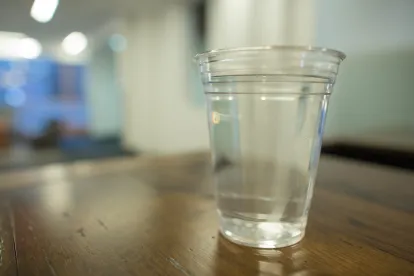On June 15, 2022, US EPA issued its prepublication notice announcing final drinking water health advisories for PFBS and GenX, as well as interim drinking water health advisories for PFOA and PFOS.1
Drinking water health advisories are published pursuant to 42 U.S.C. § 300g-1(b)(1)(F), which allows the US EPA to publish health advisories for contaminants not subject to any national primary drinking water regulation.2 They are developed “to provide information on the chemical and physical properties, occurrence and exposure, health effects, quantification of toxicological effects, other regulatory standards, analytical methods, and treatment technology for drinking water contaminants.”3 These health advisory levels are not regulations and are not considered legally enforceable standards.4 Here, we discuss US EPA’s recent announcement and consider how it could impact industries moving forward.
Drinking Water Advisory Levels for GenX, PFBS, PFOA and PFOS
The recently announced advisory levels include the following:
-
Final GenX: 10 ppt
-
Final PFBS: 2,000 ppt
-
Interim PFOA: 0.004 ppt
-
Interim PFOS: 0.02 ppt
The PFOA and PFOS levels were published as “interim” advisory levels because the Science Advisory Board is still reviewing US EPA’s analyses for these chemicals.5 According to US EPA’s pre-publication notice, these “interim updated health advisories for PFOA and PFOS supersede EPA’s 2016 health advisories for PFOA and PFOS,” which were previously 70 ppt.6 Thus, the interim advisory levels mark a drastically lower level than that which was finalized during the Obama administration just six years ago.
As anticipated, the announcement prompted varying reactions. Major national environmental groups such as the Sierra Club and Natural Resources Defense Council applauded US EPA’s announcement, but stakeholders have raised major concerns with the development of these standards. Due to the dramatic decrease in advisory levels, the new advisory levels are likely to lead to increased questions and alarm from the public and media regarding potential risks of PFAS. Moreover, entities have raised concerns regarding anticipated compliance issues given that such low advisory levels may set the stage for US EPA’s next action of developing Safe Drinking Water Act (SDWA) National Primary Drinking Water Regulations for PFOA and PFOS, especially since the health advisory levels are currently below analytical detection limits.
National Primary Drinking Water Regulations for PFOA and PFOS
US EPA will next move forward to develop Maximum Contaminant Level Goals to support SDWA National Primary Drinking Water Regulations for PFOA and PFOS. US EPA determined to develop SDWA regulations for PFOA and PFOS in March 2021.7 Consequently, by regulation, SDWA regulations for these PFAS must be proposed within 24 months of that determination and the rule finalized within 18 months after the proposal.8 According to its PFAS Strategic Roadmap, US EPA intends to propose the regulations by fall 2022 and finalize the rules by fall 2023.9 The regulations will generally take effect three years after promulgation, though this deadline could be extended for up to an additional two years.10
However, the SDWA maximum contaminant level might be set at a level higher than the health advisory levels for these same compounds, as US EPA must consider costs and benefits when setting maximum contaminant levels for the new drinking water regulations. In developing maximum contaminant levels, US EPA must “publish, seek public comment on, and use” an analysis of “[q]uantifiable and nonquantifiable costs for which there is a factual basis in the rulemaking record to conclude that such costs are likely to occur solely as a result of compliance with the maximum contaminant level,” as well as “incremental costs and benefits associated with each alternative maximum contaminant level considered.”11 If US EPA determines that the benefits of a maximum contaminant level would not justify the costs of compliance, it may “after notice and opportunity for comment, promulgate a maximum contaminant level for the contaminant that maximizes health risk reduction benefits at a cost that is justified by the benefits.”12 Consequently, after cost consideration, it is possible that the maximum contaminant levels will not be set as low as the concentration thresholds in the health advisories.
US EPA has also previously indicated that it is actively considering implications of its proposed rule to designate PFOA and PFOS as hazardous substances under the Comprehensive Environmental Response, Compensation, and Liability Act (CERCLA) in planning the new drinking water regulations. In April 2022, US EPA indicated that the agency will consider costs associated with this designation when setting the regulatory standards. The White House Office of Management and Budget has been reviewing US EPA’s proposed rule to designate PFOA and PFOS as CERCLA hazardous substances since January 2022.
US EPA’s Fact Sheet has identified measures that US EPA has deemed appropriate to reduce PFAS, including closing contaminated wells or changing the rates of blending of water sources, where the available supply is not affected, or installing technologies such as granular activated carbon, ion exchange or high-pressure membranes.13
IIJA Grant Funding for Emerging Contaminants
US EPA also announced US$1 billion in Infrastructure Investment and Jobs Act (IIJA) grant funding from the Emerging Contaminants in Small or Disadvantaged Communities Grant Program, which can be used to reduce PFAS in drinking water.14 This is the first of US$5 billion from the IIJA that will be used to address PFAS in the drinking water of small or disadvantaged communities. US EPA plans to issue guidance later this year to detail eligible funding uses and the application process. This program will complement the US$3.4 billion going to Drinking Water State Revolving Funds (SRFs) and US$3.2 billion going to Clean Water SRFs.
FOOTNOTES
1 Lifetime Drinking Water Health Advisories for Four Perfluoroalkyl Substances (PFAS), FRL 9855-01-OW (June 14, 2022), https://www.epa.gov/system/ files/documents/2022-06/prepublication-four-pfas-june-2022.pdf.
2 Id. at 4.
3 Id.
4 Id.; see also 42 U.S.C. § 300g-1(b)(1)(F).
5 Lifetime Drinking Water Health Advisories for Four Perfluoroalkyl Substances (PFAS), FRL 9855-01-OW, at 4.
6 Id. at 1, 4.
7 Announcement of Final Regulatory Determinations for Contaminants on the Fourth Drinking Water Contaminant Candidate List, 86 Fed. Reg. 12272, 12276 (Mar. 3, 2021).
8 42 U.S.C. § 300g-1(b)(1)(E).
9 U.S. EPA, PFAS Strategic Roadmap: U.S. EPA’s Commitments to Action 2021- 2024 (Oct. 2021), https://www.epa.gov/system/files/documents/2021-10/ pfas-roadmap_final-508.pdf.
10 42 U.S.C. § 300g-1(b)(10).
11 42 U.S.C. § 300g-1(b)(3)(C).
12 Id. § 300g-1(b)(6)(A).
13 See U.S. EPA, Drinking Water Health Advisories for PFAS: Fact Sheet for Public Water Systems, at 3, https://www.epa.gov/system/files/ documents/2022-06/drinking-water-ha-pfas-factsheet-water-system.pdf (discussing methods of reducing PFAS risks for public water systems).
14 U.S. EPA, EPA Announces New Drinking Water Health Advisories for PFAS Chemicals, $1 Billion in Bipartisan Infrastructure Law Funding to Strengthen Health Protections (June 15, 2022), https://www.epa.gov/newsreleases/ epa-announces-new-drinking-water-health-advisories-pfas-chemicals-1-billionbipartisan








 />i
/>i

